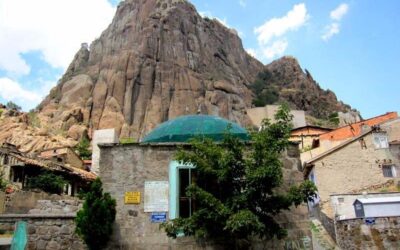Selimiye Mosque
- The Selimiye Mosque was Commissioned by Sultan Selim II and was built by the imperial architect Mimar Sinan between 1568 and 1575, built at the peak of Ottoman military and cultural power. Sultan Selim II, the son and successor of Suleiman the Magnificent, chose Edirne instead of Istanbul (the Ottoman capital) as the location to build his own sultanic Musjid. The reasons for this decision are a matter of debate among historians. Selim II appeared to have a passion for the city, having served as its governor between 1548 and 1550, and he visited it frequently after becoming sultan. Edirne, a former Ottoman capital, was also one of the most important cities in the empire and a major stop on the imperial highway between Istanbul and the Balkan provinces.
- Another of Sinan’s primary objectives was to surpass the size of the Hagia Sophia’s central dome, allegedly motivated by Christian architects who claimed that Muslims were not capable of matching the construction of that dome. Sinan’s biographies praise the dome of the Selimiye Mosque for its size and height, which is approximately the same diameter as the Hagia Sophia’s main dome and slightly higher; the first time that this had been achieved in Ottoman architecture. The hemispherical dome has a diameter of 31.28 metres (102.6 ft). Its exact height is sometimes disputed but is approximately 42 metres (138 ft)
Other buildings of the complex:
- The Musjid stands at the center of a külliye (a religious and charitable complex) within an outer perimeter wall, occupying an elevated site measuring approximately 130 by 190 metres (430 by 620 ft).
- The complex includes two madrasas: the Dar’ül Kurra Medrese (a school for Qur’anic recitation) and a Dar-ül Hadis Medrese (a hadith school).
- The Dar’ül Kurra Medrese occupies the southeastern corner of the complex and the Dar-ül Hadis Medrese occupies the northeastern corner, both arranged in a symmetrical configuration around the main axis of the complex.
- Both structures consist of an internal square courtyard surrounded by porticos on four sides, rows of small domed rooms on two sides, and a larger domed dershane (classroom) on one side. Both were completed by Sinan while he was still in Edirne to oversee the Musjid’s construction.
- The Dar’ül Kurra Medrese now houses the Selimiye Foundation Museum (Selimiye Vakıf Müzesi), which opened in 2006 and displays art and artefacts from religious foundations (vakifs) in and around Edirne.
- It was previously converted to a city museum in 1930, on the orders of Atatürk, then served various other functions including an office, a student hostel, and a warehouse, before the current museum.
- The Dar-ül Hadis Medrese now houses the Museum of Turkish and Islamic Arts of Edirne (Türk İslam Eserleri Müzesi), which displays objects of Islamic art from the region of Edirne as well as objects granted from the collections of the Topkapı Palace Museum and the Ethnography Museum of Ankara. It was first opened in 1925 and was reopened in 2012 after a long restoration.
- The complex also includes a sibyan mektebi (elementary school) and an arasta (covered market street), located along the southern perimeter of the complex. These were added later and it’s possible that they were completed instead by Davud Agha, Sinan’s successor as chief court architect, though Sinan may have designed them. The sibyan mektebi consists of a domed hall adjoined by an open portico on its southwest side.
Later history:
- The Musjid underwent its first repairs by Sinan in 1584, after minor damage caused by lightning. An earthquake in 1752 also caused minor damage. In 1808 some of the calligraphic decoration in the Musjid was restored and a roof was added over the courtyard fountain, though it has since disappeared. During the reign of Abdülmecid I (1839–1861), the Musjid’s interior was re-plastered and its decoration redone, in a style partially imitating the former ornamentation.
- The Selimiye Mosque (Turkish: Selimiye Camii) is an Ottoman imperial Musjid, located in the city of Edirne (formerly Adrianople), Turkey. It was commissioned by Sultan Selim II and was built by the imperial architect Mimar Sinan between 1568 and 1575. It was considered by Sinan to be his masterpiece and is one of the highest achievements of Islamic architecture as a whole and Ottoman architecture in particular.








